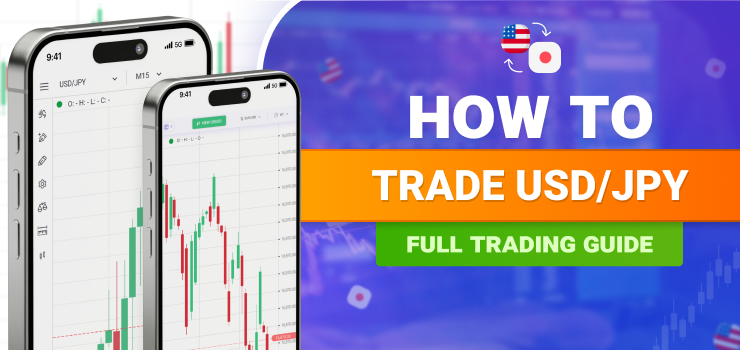The USD/JPY currency pair, representing the value of the US dollar versus the Japanese yen, is one of the most actively traded currency pairs in the global foreign exchange (forex) market. With average daily trading volumes exceeding $150 billion, USD/JPY offers traders excellent liquidity and tight spreads.
In this comprehensive guide, we’ll cover everything you need to know to start trading USD/JPY like a pro. We’ll explore fundamental and technical analysis techniques, discuss trading strategies, explain order types and account management best practices, and provide resources for ongoing education. By the end, you’ll have a solid foundation to begin navigating this versatile currency pair with confidence.
What Drives USD/JPY?
Understanding the factors influencing USD/JPY is essential for effective trading. Key drivers include:
- Interest Rates – The interest rate differential between the US and Japan is a primary determinant, as higher US rates make dollar-denominated assets more attractive.
- Risk Sentiment – When risk appetite rises, traders typically buy the higher-yielding dollar and sell the safe-haven yen. This dynamic reverses during risk-off periods.
- US Economic Data – Key stats like inflation, retail sales, GDP, and employment numbers impact USD/JPY flows by altering the outlook for US monetary policy.
- Japan Data – Domestic factors like wage growth, factory output, and bank lending shape yen demand. Soft data often pressures the currency.
- Geopolitics – Global tensions involving the US or Japan can influence risk-on/risk-off dynamics and change relative currency valuations.
Monitoring economic indicators and international news provides context for price behavior. Understanding drivers lets you anticipate reactionary market moves.
USD/JPY Fundamental Analysis
Fundamental analysis examines macro factors to spot long-term opportunities. Some techniques for USD/JPY include:
- Relative Growth Comparison – Analyze US vs. Japan GDP, industrial production, and job markets to gauge economic momentum differentials. This reveals which currency may strengthen.
- Interest Rate Forecasts – Project the path of US rates compared to Japan based on inflation expectations and central bank communication. Position accordingly.
- Policy Assessment – Scrutinize fiscal, and monetary policies to identify divergence that could move exchange rates, such as altering interest rate differentials.
- Risk Appetite – Evaluate geopolitical tensions, speculative flows, and risk events to predict “haven” currency demand shifts between the dollar and yen.
Supplement fundamental signals with technicals and trade only well-researched views. Fundamentals shift gradually, so employ patience. Focus on high-probability setups where analysis aligns.
USD/JPY Technical Analysis
Pair technical analysis with fundamentals for a comprehensive trading approach. Popular technical tools for USD/JPY include:
- Trend Lines – Identify support/resistance levels from past price action to gauge trend strength and find high-probability entry points.
- Moving Averages – Track signals from the 9, 21, 50, and 200-day MAs to time trades according to crossover patterns in bullish or bearish conditions.
- Candlestick Patterns – Formations like pin bars, engulfing candles, and morning/evening stars signal potential reversals near support/resistance for entries.
- Fibonacci Retracements – Apply retracement levels from past swings (23.6%, 38.2%, 61.8%) to gauge healthy pullbacks seeking new positions.
- Momentum Oscillators – Evaluate RSI, Stochastics, and MACD divergences to spot overbought/oversold situations for well-timed entries in the direction of the trend.
- Technical Confirmation – Wait for fundamentals and multiple timeframes/indicators to align before entering to maximize chances of success.
USD/JPY Trading Strategies
With a solid understanding of fundamentals and technicals in hand, you can start implementing proven trading strategies on USD/JPY. Here are some popular approaches:
Trend Trading
Identify short, medium, and long-term trends using moving averages and trade in the direction of the higher timeframe trend for profits. Scale in on pullbacks.
Range Trading
Look for periods of consolidation between key levels and trade mean reversions by entering near supports or resistances. Use range breakouts to find directional moves.
Day Trading
Scalp short-term price fluctuations throughout the day, using indicators like Bollinger Bands or daily ranges and closing positions before market close. Requires experience and discipline.
Carry Trading
Capitalize on interest rate differentials by borrowing the low-yield currency to purchase the high-yield one and holding for the interest rate carry. Risky but potentially rewarding.
News Trading
Position ahead of scheduled news releases with expectations for positive or negative reactions. Exit quickly after announcements to avoid volatility.
Swing Trading
Hold positions from a few days to several weeks using fundamentals and technical confirmations. Place protective stops to limit losses on reversals.
Regardless of strategy, money management is paramount. Use low leverage, trade small position sizes, and cut losses quickly to survive in this volatile market.
Order Types For Trading
Traders have more flexibility and control over when to join and exit positions in the market when they can use various order types efficiently. Individuals who trade USD/JPY must be aware of their options.
Among the simplest is the market order, which offers instantaneous execution at the best price on the market but has a risk of slippage if prices shift suddenly before filling. A pending order, such as a limit or stop order, is an additional trading instrument that remains active until a predetermined price threshold is reached. More control over the entry level is made possible by this. Other order types, such as take profits and stop-losses, help with profit-locking and risk management once a position is established.
When losses exceed a certain threshold, a stop-loss order immediately closes the transaction and sets a predetermined exit price. In the meanwhile, a take-profit order secures profits without continuous supervision by setting a target price that, if met, automatically causes the position to close in the money.
It is strongly advised that new traders take some time to familiarize themselves with order types on a demo account, test out various scenarios to see how they work in actual market circumstances, and steer clear of unanticipated order slippage or missed exits before engaging in real money trading. Order selection and application are crucial tools that traders may use to actively control the risk/reward of their holdings.
Account Management For Trading
A well-managed trading account is half the battle. Follow these best practices:
- Set realistic profit targets from technical analysis (e.g. Fibonacci extensions) rather than greed. Take gains and replenish capital.
- Employ a risk management system with no more than 2% risk per trade, with stops in place before entering to lock in losses at a predefined point.
- Diversify capital across several currency pairs to reduce reliance on any single market’s fluctuations.
- Maintain a daily trading journal chronicling strategy performance to objectively review what’s working and identify weaknesses to improve over time.
- Calculate your risk-reward ratio – aims should be at least 2:1 or higher on every setup for an edge.
- Have an established money management plan and only trade with risk capital so emotions don’t cloud decisions. Preserve capital for the long run.



